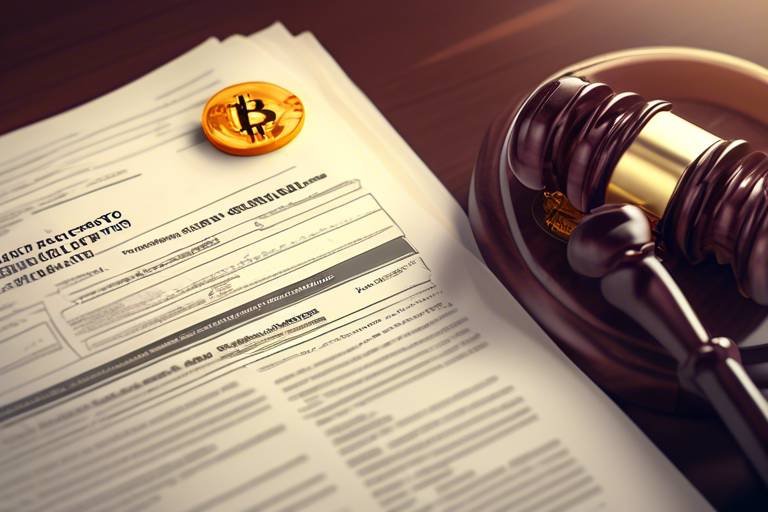Evaluating the Future of Crypto Regulation and Compliance
The world of cryptocurrency is like a wild west—exciting, unpredictable, and filled with opportunities that can be as vast as the ocean. However, as we dive deeper into this digital currency realm, the need for **regulation** and **compliance** becomes increasingly apparent. The **future of crypto regulation** is not just a topic for policymakers and investors; it’s a conversation that affects everyone involved in this burgeoning industry. With the rapid evolution of technology and market dynamics, the frameworks that govern cryptocurrencies are also undergoing significant transformations. This article will explore the evolving landscape of cryptocurrency regulation, examining potential frameworks, compliance challenges, and the implications for investors and businesses in the digital currency space.
As it stands, the **current state of crypto regulation** varies dramatically across the globe. Different jurisdictions have adopted unique approaches, which can be as diverse as the cryptocurrencies themselves. For instance, while some countries embrace digital currencies with open arms, others impose strict bans. This patchwork of regulations creates a complex environment for stakeholders. In the United States, the regulatory landscape is fragmented, with agencies like the SEC and CFTC vying for jurisdiction over different aspects of cryptocurrency. Meanwhile, the European Union is working towards a more unified regulatory framework, aiming to create a **Digital Markets Act** that could streamline compliance across member states. The challenges faced by regulators are immense; they must keep pace with rapid technological advancements while ensuring consumer protection and market integrity.
As we look ahead, several **emerging regulatory trends** are shaping the future of cryptocurrency. One of the most notable is the rise of **Decentralized Finance (DeFi)**, which has prompted governments to rethink their regulatory approaches. The decentralized nature of these platforms presents unique challenges, as they operate without a central authority, making it difficult to enforce traditional regulations. Governments are beginning to recognize the need for innovative frameworks that can adapt to these new market dynamics. For instance, countries like Switzerland and Singapore are leading the way by creating regulatory sandboxes that encourage innovation while maintaining oversight. This approach allows businesses to experiment with new technologies in a controlled environment, fostering growth without compromising safety.
When comparing **global regulatory approaches**, we see a spectrum of strictness and flexibility. In the European Union, regulations are becoming more comprehensive, with the MiCA (Markets in Crypto-Assets) proposal aiming to create a harmonized framework across member states. Conversely, in the United States, the regulatory environment remains fragmented, with various states implementing their own rules. In Asia, countries like Japan have established clear guidelines for exchanges, while others, like China, have opted for outright bans on cryptocurrency transactions. This inconsistency can create confusion for businesses and investors alike, who must navigate a complex web of rules. The challenge lies in finding a balance between fostering innovation and ensuring consumer protection.
Examining specific examples of successful regulations offers valuable insights into best practices for future frameworks. For instance, **Switzerland** has emerged as a crypto-friendly nation by implementing clear guidelines that support innovation while protecting consumers. The Swiss Financial Market Supervisory Authority (FINMA) has established a framework that allows crypto companies to operate legally while adhering to anti-money laundering (AML) and securities laws. Similarly, **Singapore** has created a progressive regulatory environment through its Payment Services Act, which provides clarity for businesses while ensuring consumer protection. These case studies illustrate that effective regulation can foster growth and innovation in the cryptocurrency space.
Despite the progress being made, there are significant **challenges in implementation** that regulators must navigate. Technological barriers pose a substantial obstacle, as many regulators lack the expertise to fully understand the complexities of blockchain technology. Additionally, resource limitations can hinder the ability of regulatory bodies to enforce compliance effectively. The constantly evolving nature of the crypto market also complicates matters, as new products and platforms emerge at a rapid pace. Regulators must be agile, adapting their frameworks to keep up with these changes while ensuring that they do not stifle innovation.
The implications of regulatory changes extend beyond policymakers; they significantly affect various market participants, including **investors**, **exchanges**, and **blockchain developers**. For investors, regulatory clarity can provide a sense of security, encouraging more people to enter the market. However, stringent regulations may also deter investment, as individuals weigh the risks of compliance against potential returns. Exchanges, on the other hand, must navigate the complexities of compliance, often investing heavily in legal and operational resources to meet regulatory demands. For blockchain developers, the evolving regulatory landscape can either hinder innovation or inspire new solutions that align with compliance requirements. Ultimately, the way regulations are shaped will determine the future dynamics of the crypto market.
Operating in the crypto space comes with its own set of **compliance challenges**. Businesses must contend with a myriad of requirements, including **anti-money laundering (AML)** regulations and the need for robust reporting systems. Failure to comply can result in severe penalties, including hefty fines and reputational damage. Moreover, the lack of standardization across jurisdictions complicates compliance efforts, as businesses must adapt to different rules in each market they operate in. As the regulatory landscape continues to evolve, staying ahead of compliance requirements will be crucial for businesses looking to thrive in the crypto space.
To navigate the complex world of compliance, businesses can adopt several **best practices**. Implementing comprehensive training programs for staff can help ensure that everyone understands their compliance obligations. Additionally, leveraging technology, such as automated reporting tools and compliance software, can streamline processes and reduce the risk of human error. Regular audits and assessments can also help identify potential compliance gaps, allowing businesses to address issues proactively. By adopting these strategies, companies can maintain operational efficiency while ensuring they remain compliant with evolving regulations.
Advancements in **technology** play a pivotal role in helping businesses meet compliance demands. Tools like **blockchain analytics** and **smart contracts** can enhance transparency and accountability, making it easier for businesses to track transactions and ensure compliance with regulatory requirements. Blockchain analytics, for instance, can provide valuable insights into transaction patterns, helping businesses identify suspicious activities and report them to authorities. Smart contracts can automate compliance processes, reducing the burden on businesses while ensuring adherence to regulations. As technology continues to evolve, it will undoubtedly shape the future of compliance in the cryptocurrency space.
- What is cryptocurrency regulation? Cryptocurrency regulation refers to the laws and guidelines that govern the use, trading, and development of digital currencies.
- Why is compliance important in the crypto space? Compliance is essential to ensure that businesses operate within legal frameworks, protect consumers, and maintain the integrity of the market.
- How can businesses stay compliant with regulations? Businesses can stay compliant by implementing robust compliance programs, leveraging technology, and staying informed about regulatory changes.

The Current State of Crypto Regulation
The world of cryptocurrency is like a thrilling roller coaster ride—full of ups and downs, twists and turns. As the digital currency landscape evolves at breakneck speed, so does the regulatory framework that seeks to govern it. Currently, the state of crypto regulation varies significantly across different jurisdictions, creating a mosaic of rules that can be both confusing and challenging for investors and businesses alike. In the United States, for instance, the regulatory environment is often described as fragmented. Various agencies, such as the Securities and Exchange Commission (SEC) and the Commodity Futures Trading Commission (CFTC), have overlapping jurisdictions, leading to a lack of clarity on which rules apply to different cryptocurrencies. This can leave businesses scratching their heads, unsure of how to proceed without running afoul of the law.
Across the pond in Europe, the regulatory landscape is somewhat more unified, thanks to the European Union's efforts to create a comprehensive framework for digital assets. The proposed Markets in Crypto-Assets (MiCA) regulation aims to standardize rules across member states, providing a clearer path for businesses to follow. However, even within the EU, there are significant differences in how individual countries interpret and implement these regulations. For example, Germany has embraced cryptocurrencies with open arms, offering a legal framework that encourages innovation, while other countries may still be hesitant, imposing stricter controls.
Meanwhile, in Asia, countries like China have taken a hardline approach, outright banning cryptocurrencies and Initial Coin Offerings (ICOs) in a bid to maintain control over their financial systems. In stark contrast, nations like Singapore and Japan have adopted a more progressive stance, recognizing the potential of blockchain technology and actively seeking to foster a thriving crypto ecosystem. This patchwork of regulations poses unique challenges for global businesses that operate across borders, as they must navigate a labyrinth of rules that can change from one jurisdiction to another.
One of the biggest challenges regulators face is keeping pace with the rapid technological advancements in the crypto space. With innovations like decentralized finance (DeFi) and non-fungible tokens (NFTs) emerging at lightning speed, traditional regulatory frameworks often struggle to adapt. As a result, regulators are increasingly looking to engage with industry stakeholders to better understand the technology and its implications. This collaborative approach can help create regulations that are not only effective but also conducive to innovation.
To summarize, the current state of crypto regulation is a complex and evolving landscape characterized by a mix of strict and lenient approaches across various jurisdictions. While some countries are leading the charge in establishing clear guidelines, others remain cautious, creating challenges for businesses and investors. As the digital currency market continues to grow, it is crucial for regulators to strike a balance between fostering innovation and ensuring consumer protection. Only time will tell how this regulatory puzzle will unfold, but one thing is for sure: the journey is sure to be as exciting as the world of crypto itself.

Emerging Regulatory Trends
The world of cryptocurrency is in a constant state of flux, and with it, the regulatory landscape is evolving at an unprecedented pace. As decentralized finance (DeFi) continues to gain traction, governments worldwide are scrambling to adapt their regulatory frameworks to address the unique challenges and opportunities presented by this innovative sector. It's like trying to catch smoke with your bare hands—just when you think you’ve got a grip, it slips away, revealing new complexities and risks. This section delves into the latest trends in cryptocurrency regulation, highlighting how regulators are responding to the changing dynamics of the market.
One of the most notable trends is the shift towards proactive regulation. Unlike the reactive measures of the past, regulators are now looking to anticipate and mitigate risks before they escalate. This approach is not just about enforcing compliance; it’s about fostering a safe environment for innovation. For instance, countries like Switzerland and Singapore have implemented forward-thinking frameworks that encourage blockchain development while ensuring consumer protection. These nations serve as prime examples of how regulation can coexist with innovation, creating a balanced ecosystem that benefits all stakeholders.
Another emerging trend is the increasing focus on international collaboration. As cryptocurrencies operate on a global scale, disparate regulations can create a patchwork of compliance challenges for businesses. To address this, international bodies such as the Financial Action Task Force (FATF) are working towards establishing standardized guidelines that can be adopted by member countries. This harmonization of regulations aims to simplify compliance for businesses operating in multiple jurisdictions and reduce the risk of regulatory arbitrage. It’s akin to setting the same rules for a global game—everyone knows what to expect, and it levels the playing field.
Moreover, the rise of stablecoins has caught the attention of regulators. These digital currencies, pegged to traditional assets like the US dollar, offer the promise of stability in a notoriously volatile market. However, their growing popularity has raised questions about monetary policy, consumer protection, and financial stability. As a result, regulators are beginning to scrutinize stablecoin issuers more closely, seeking to ensure that they maintain adequate reserves and comply with existing financial regulations. This scrutiny is crucial, as it helps to build trust in these new financial instruments and protect consumers from potential risks.
Additionally, we are witnessing the emergence of tailored regulations for specific sectors within the crypto space. For example, the rise of non-fungible tokens (NFTs) has prompted regulators to consider how existing laws apply to these unique digital assets. Some jurisdictions are exploring the creation of new frameworks specifically designed for NFTs, which would address issues such as copyright, ownership, and taxation. This sector-specific approach allows regulators to craft more effective policies that reflect the nuances of different types of digital assets.
As we look towards the future, it's clear that the regulatory landscape for cryptocurrency will continue to evolve. The challenge for regulators will be to strike a balance between fostering innovation and ensuring consumer protection. With technology advancing at breakneck speed, the need for agile regulatory frameworks has never been more pressing. It’s a delicate dance, where one misstep could lead to stifling innovation or, conversely, exposing consumers to undue risk. The key will be to maintain an open dialogue between regulators, businesses, and the crypto community, ensuring that all voices are heard as we navigate this uncharted territory.

Global Regulatory Approaches
The world of cryptocurrency is a vast and dynamic landscape, and as it continues to evolve, so do the regulatory frameworks that govern it. Different countries are taking varied approaches to cryptocurrency regulation, reflecting their unique economic environments, technological advancements, and cultural attitudes towards innovation. While some nations embrace cryptocurrencies with open arms, others remain cautious or even hostile. This diversity creates a patchwork of regulations that can be challenging for businesses and investors alike.
For instance, in the United States, the regulatory approach is characterized by a mix of federal and state regulations. The Securities and Exchange Commission (SEC) plays a pivotal role in determining whether certain cryptocurrencies are classified as securities, which subjects them to stringent regulations. Meanwhile, states like Wyoming are pioneering more crypto-friendly laws to attract blockchain businesses. This duality can lead to confusion, as companies must navigate a complex regulatory environment that varies significantly from one state to another.
On the other hand, the European Union (EU) is working towards a more cohesive regulatory framework through initiatives like the Markets in Crypto-Assets (MiCA) regulation. MiCA aims to provide clarity and consistency across member states, fostering innovation while ensuring consumer protection. However, the challenge remains in balancing regulation with the need for flexibility in a rapidly changing market. The EU's approach is often seen as more comprehensive compared to the fragmented approach in the US, but it also faces criticism for being potentially stifling to innovation.
In Asia, countries like China have taken a hardline stance against cryptocurrencies, banning initial coin offerings (ICOs) and shutting down domestic exchanges. Conversely, nations like Singapore have adopted a more supportive regulatory framework, encouraging the development of blockchain technology while implementing measures to prevent money laundering and fraud. This contrast highlights a significant divergence in how different regions view the potential of cryptocurrencies and their associated risks.
To illustrate these varying approaches, the following table summarizes the regulatory stance of several key players in the global cryptocurrency market:
| Country/Region | Regulatory Stance | Key Regulatory Body |
|---|---|---|
| United States | Mixed; state and federal regulations | SEC, CFTC |
| European Union | Developing a cohesive framework (MiCA) | European Commission |
| China | Strict; bans on ICOs and exchanges | People's Bank of China |
| Singapore | Supportive; encourages innovation | Monetary Authority of Singapore |
The implications of these regulatory approaches are profound. For businesses operating in the crypto space, understanding the regulatory landscape is crucial for compliance and strategic planning. The differences in regulations can affect everything from initial coin offerings to daily operations and reporting requirements. As the global regulatory environment continues to evolve, staying informed and adaptable will be key for anyone involved in cryptocurrency.
In conclusion, the global regulatory approaches to cryptocurrency vary widely, reflecting a complex interplay of economic, cultural, and technological factors. As we move forward, it's essential for stakeholders to engage with these regulations actively, advocating for frameworks that promote innovation while ensuring consumer protection. The future of cryptocurrency regulation will undoubtedly shape the next chapter in the story of digital currencies.
- What is the purpose of cryptocurrency regulation?
Cryptocurrency regulation aims to protect consumers, prevent fraud, and mitigate risks associated with digital currencies while fostering innovation in the financial sector.
- How do regulations differ between countries?
Regulations vary significantly based on a country's economic goals, technological readiness, and cultural attitudes towards cryptocurrencies, leading to a diverse regulatory landscape.
- What challenges do businesses face with compliance?
Businesses often grapple with complex regulations, varying compliance requirements across jurisdictions, and the need for robust reporting systems to meet anti-money laundering (AML) standards.

Case Studies of Successful Regulations
When we talk about successful regulations in the cryptocurrency space, it's essential to highlight specific case studies that demonstrate how thoughtful regulatory frameworks can foster innovation while ensuring consumer protection. One of the standout examples is Switzerland, often regarded as a pioneer in crypto regulation. The Swiss Financial Market Supervisory Authority (FINMA) has implemented a clear framework that allows blockchain companies to operate while adhering to strict guidelines. This approach has created a thriving ecosystem, attracting numerous startups and established firms alike. The clarity in regulations has not only enhanced investor confidence but has also encouraged innovation in financial technology.
Another notable case is Singapore, where the Monetary Authority of Singapore (MAS) has adopted a forward-thinking regulatory stance. By introducing the Payment Services Act, Singapore has created a comprehensive licensing regime that covers various digital payment services, including cryptocurrency exchanges. This legal clarity has made Singapore a hub for blockchain innovation, with many firms establishing their headquarters there. The MAS actively engages with industry players, ensuring that regulations evolve in tandem with technological advancements, which is a crucial aspect of effective regulation.
In the European Union, the MiCA (Markets in Crypto-Assets) Regulation is a promising initiative aimed at creating a unified regulatory framework across member states. This regulation seeks to provide clarity on the treatment of cryptocurrencies and stablecoins, fostering a safer environment for investors while promoting market integrity. By establishing a level playing field, MiCA could potentially enhance the EU's attractiveness as a destination for crypto businesses, encouraging investment and innovation.
However, successful regulation isn't just about creating rules; it's about implementing them effectively. A significant challenge faced by regulators is ensuring that compliance measures do not stifle innovation. For example, in Germany, the Federal Financial Supervisory Authority (BaFin) has taken a balanced approach by recognizing cryptocurrencies as units of account, thereby subjecting them to financial regulations. This recognition has encouraged the development of crypto-related financial products while ensuring consumer protection.
To summarize, these case studies illustrate that successful regulation in the cryptocurrency space requires a delicate balance between fostering innovation and ensuring consumer protection. The key takeaways from these examples include:
- Clarity in Regulations: Clear guidelines help businesses understand their obligations and foster a conducive environment for growth.
- Engagement with Industry: Regulators that actively engage with industry stakeholders are better positioned to adapt to changes and challenges.
- Flexibility: Regulations should be adaptable to keep pace with rapid technological advancements.
As we look toward the future, these case studies provide valuable insights into how regulatory frameworks can evolve to support the dynamic nature of the cryptocurrency market. They serve as a roadmap for other jurisdictions aiming to create effective regulations that promote innovation while safeguarding investors.
- What are the main benefits of effective cryptocurrency regulation? Effective regulation promotes investor confidence, protects consumers, and encourages innovation in the financial technology sector.
- How can countries create a balanced regulatory framework? Countries can create a balanced framework by engaging with industry stakeholders, ensuring clarity in regulations, and allowing for flexibility to adapt to technological changes.
- What role does technology play in compliance? Technology aids compliance by providing tools for monitoring transactions, enhancing transparency, and automating reporting processes, making it easier for businesses to adhere to regulations.

Challenges in Implementation
The implementation of cryptocurrency regulations is not just a walk in the park; it’s more like navigating a labyrinth filled with unexpected twists and turns. As regulators strive to keep pace with the rapid advancements in technology, they encounter a myriad of challenges that can hinder effective compliance. One of the most significant challenges is the technological barrier. The crypto landscape is characterized by its complexity and rapid evolution. New technologies emerge almost daily, making it difficult for regulators to develop frameworks that are both comprehensive and adaptable. Imagine trying to catch a moving train while it’s speeding down the tracks; that’s how regulators often feel when trying to keep up with the pace of innovation.
Another hurdle is the resource limitation faced by many regulatory bodies. With limited budgets and personnel, it can be challenging to monitor and enforce compliance across a vast and decentralized market. This is particularly true for smaller jurisdictions that may lack the financial and technical resources needed to implement effective regulatory measures. In such cases, the risk of non-compliance increases, which can lead to significant repercussions for both investors and businesses. It’s like trying to put out a fire with a garden hose; the resources just aren’t sufficient to manage the situation effectively.
Moreover, the constantly evolving nature of the crypto market presents an ongoing challenge. Regulations that may have been effective yesterday might be outdated tomorrow. This fluidity requires regulators to be not just reactive, but proactive, constantly assessing and revising their approaches to address emerging risks. The challenge here is akin to trying to hit a moving target; as soon as you think you’ve got it, it shifts again. Additionally, the lack of a standardized framework across different jurisdictions complicates matters even further. It creates a patchwork of regulations that businesses must navigate, leading to confusion and potential non-compliance.
To illustrate these challenges, consider the following table that summarizes key implementation obstacles:
| Challenge | Description |
|---|---|
| Technological Barriers | Difficulty in keeping up with rapid technological advancements and innovations. |
| Resource Limitations | Insufficient budgets and personnel to effectively monitor and enforce compliance. |
| Evolving Market | Need for constant updates to regulations due to the dynamic nature of the crypto market. |
| Lack of Standardization | Variability in regulations across jurisdictions leading to confusion for businesses. |
In summary, the road to effective crypto regulation is fraught with challenges that require innovative solutions and collaborative efforts among stakeholders. Regulators must engage with industry experts, invest in technology, and foster a culture of compliance to ensure that they can navigate this complex landscape. After all, in the world of cryptocurrency, staying ahead of the curve isn’t just beneficial; it’s essential for the protection of all market participants.
- What are the main challenges faced by regulators in the crypto space?
Regulators face challenges such as technological barriers, resource limitations, the evolving nature of the market, and a lack of standardized regulations across jurisdictions.
- Why is it difficult for regulators to keep pace with cryptocurrency advancements?
The rapid pace of technological innovation in the crypto market makes it hard for regulators to create effective and adaptable regulatory frameworks.
- How do resource limitations affect regulatory compliance?
Limited budgets and personnel can hinder the ability of regulatory bodies to monitor and enforce compliance effectively, increasing the risk of non-compliance.
- What can be done to overcome these challenges?
Engaging with industry experts, investing in technology, and fostering a culture of compliance are essential steps regulators can take to navigate the complexities of the crypto landscape.

Impact on Market Participants
The impact of regulatory changes in the cryptocurrency landscape is profound and multifaceted, affecting various market participants in distinct ways. For investors, new regulations can bring a sense of security and trust to the market, as they often aim to protect consumers from fraud and manipulation. However, these same regulations can also impose limitations on trading practices and investment strategies, leading to a more cautious approach among investors. Imagine trying to navigate a thrilling roller coaster ride while being strapped into a safety harness; the thrill is there, but the freedom is somewhat curtailed.
On the other hand, cryptocurrency exchanges are significantly impacted by compliance requirements. With the introduction of stringent anti-money laundering (AML) and know-your-customer (KYC) regulations, exchanges must invest heavily in technology and personnel to ensure compliance. This can lead to increased operational costs, which may ultimately be passed on to users in the form of higher fees. As a result, the competitive landscape among exchanges may shift, favoring those that can efficiently manage compliance without compromising user experience.
For blockchain developers, the evolving regulatory environment presents both challenges and opportunities. While some developers may feel stifled by regulations that seem to limit innovation, others may find new avenues for growth. For instance, projects that prioritize transparency and compliance are likely to attract more institutional investors. This shift could lead to a more mature market, where projects that adhere to regulatory standards gain a competitive edge. It's akin to a garden where the flowers that bloom are those nurtured by both sunlight and rain—regulation can be a double-edged sword.
Moreover, the implications extend beyond just individual stakeholders. The entire ecosystem is affected, including financial institutions, which are increasingly looking to integrate cryptocurrencies into their offerings. As regulations become clearer, banks and traditional financial institutions may feel more comfortable engaging with digital assets, paving the way for innovative products and services. This could lead to a hybrid financial system where traditional and digital currencies coexist, creating a more dynamic marketplace.
To illustrate the varying impacts on different market participants, consider the following table:
| Market Participant | Positive Impact | Negative Impact |
|---|---|---|
| Investors | Increased security and trust | Potential limitations on trading |
| Exchanges | Enhanced reputation and user trust | Higher operational costs and fees |
| Developers | Attracting institutional investment | Stifled innovation in some areas |
| Financial Institutions | Integration of crypto offerings | Compliance complexities |
In summary, the impact of regulatory changes on market participants is complex and varied. While some may experience enhanced security and new opportunities, others may face challenges that require adaptation and resilience. As the landscape continues to evolve, it is essential for all stakeholders to stay informed and agile, ready to navigate the twists and turns of this exhilarating ride.
- What are the main impacts of crypto regulation on investors?
Investors may experience increased security and trust but could also face limitations on trading practices.
- How do exchanges adapt to new compliance requirements?
Exchanges often invest in technology and personnel to meet compliance standards, which can lead to higher operational costs.
- What opportunities do regulations present for blockchain developers?
Developers can attract institutional investments by prioritizing transparency and compliance, leading to a more mature market.
- How will financial institutions react to clearer regulations?
With clearer regulations, financial institutions may feel more comfortable integrating cryptocurrencies into their offerings, creating innovative products.

Compliance Challenges for Businesses
The world of cryptocurrency is like a thrilling roller coaster ride—full of ups, downs, and unexpected twists. For businesses operating in this dynamic environment, compliance challenges can often feel overwhelming. As regulations evolve, companies must adapt quickly to avoid falling behind or facing penalties. One of the primary hurdles is meeting anti-money laundering (AML) requirements. These regulations demand that businesses implement stringent measures to detect and prevent illicit activities, which can be particularly complex in the decentralized world of crypto.
Moreover, the need for robust reporting systems is another significant challenge. Companies must maintain detailed records of transactions and customer identities, which can be a daunting task given the anonymity that cryptocurrencies often provide. This requirement not only demands advanced technology but also a skilled workforce capable of navigating the intricate web of legal obligations.
In addition to AML, businesses face compliance with various other regulations, such as the Know Your Customer (KYC) processes. KYC regulations require businesses to verify the identity of their clients, which can lead to friction in user experience. Imagine trying to sign up for a service and facing a mountain of paperwork—frustrating, right? This can deter potential customers who are looking for a seamless onboarding process.
Another layer of complexity arises from the fact that regulations can vary significantly across different jurisdictions. For example, a company operating in the European Union may find itself adhering to stricter rules than one in a more lenient market like some parts of Asia. This inconsistency can create a patchwork of compliance requirements, making it challenging for businesses to operate globally. To illustrate this, consider the following table comparing regulatory approaches in various regions:
| Region | Regulatory Approach | Key Challenges |
|---|---|---|
| United States | Strict, with multiple regulatory bodies | Complexity and fragmentation |
| European Union | Comprehensive, with GDPR implications | Data protection compliance |
| Asia | Varied, with some countries embracing crypto | Inconsistent regulations |
As businesses grapple with these challenges, they must also consider the potential consequences of non-compliance. Fines, legal action, and reputational damage can all stem from failing to adhere to regulations. It’s not just about avoiding penalties; it’s about building trust with customers and stakeholders. In a world where transparency is king, demonstrating compliance can serve as a competitive advantage.
In conclusion, while the path to compliance in the crypto space is fraught with challenges, it is not insurmountable. Companies that invest in understanding the regulatory landscape, implementing effective systems, and fostering a culture of compliance will not only survive but thrive in this exciting new frontier. The key is to stay informed and agile, ready to pivot as regulations continue to evolve.
- What are the main compliance challenges businesses face in cryptocurrency? Businesses often struggle with AML requirements, KYC processes, and varying regulations across jurisdictions.
- How can businesses ensure they remain compliant? By investing in technology, training staff, and staying updated on regulatory changes, businesses can navigate compliance challenges effectively.
- What are the consequences of non-compliance? Non-compliance can lead to fines, legal repercussions, and damage to a company’s reputation.

Best Practices for Compliance
In the rapidly evolving landscape of cryptocurrency, ensuring compliance is not just a legal obligation; it's a strategic advantage. As businesses navigate this complex environment, adopting can significantly enhance their operational integrity and reputation. One of the first steps is to establish a robust compliance framework that aligns with both local and international regulations. This framework should be dynamic, allowing for adjustments as regulations evolve. Think of it as a living document that grows alongside the business, adapting to new challenges and opportunities.
Furthermore, training and awareness are crucial. Employees should be well-versed in the compliance requirements specific to their roles. Regular training sessions can help in keeping the team updated on the latest regulations and compliance strategies. It’s akin to having a well-oiled machine; every part needs to function seamlessly to ensure the entire system runs smoothly. This not only minimizes the risk of non-compliance but also fosters a culture of accountability and transparency within the organization.
Another vital aspect is the implementation of anti-money laundering (AML) protocols. Businesses must develop and maintain comprehensive AML policies that include customer due diligence, transaction monitoring, and reporting suspicious activities. For instance, utilizing advanced software solutions for transaction monitoring can significantly enhance a company's ability to detect irregularities. By leveraging technology, businesses can automate many compliance processes, reducing the likelihood of human error while also saving time and resources.
Moreover, maintaining accurate and detailed records is essential for compliance. A well-organized documentation system can serve as a lifeline during audits or regulatory reviews. Companies should ensure that all transactions, communications, and compliance activities are documented meticulously. This not only aids in meeting regulatory obligations but also provides a historical record that can be invaluable for future reference. In this digital age, utilizing cloud-based solutions for record-keeping can enhance accessibility and security.
Additionally, businesses should engage with legal and compliance experts who specialize in cryptocurrency regulations. Their expertise can provide insights into navigating the intricacies of compliance and help in identifying potential risks before they become issues. It’s like having a seasoned navigator on a ship; they can guide you through treacherous waters and help you avoid potential pitfalls.
Lastly, fostering an open line of communication with regulatory bodies can be beneficial. By establishing a rapport with regulators, businesses can gain insights into upcoming regulatory changes and expectations. This proactive approach can position a company as a leader in compliance, paving the way for smoother operations and enhanced credibility in the market.
In summary, the key to successful compliance in the cryptocurrency space lies in establishing a solid framework, investing in employee training, implementing robust AML protocols, maintaining meticulous records, consulting with experts, and engaging with regulators. By following these best practices, businesses can navigate the compliance landscape with confidence and agility, ensuring they remain on the right side of the law while fostering innovation and growth.
- What are the primary compliance challenges in the cryptocurrency industry? Compliance challenges include adhering to anti-money laundering (AML) regulations, maintaining accurate records, and ensuring proper customer due diligence.
- How can technology aid in compliance? Technology can streamline compliance processes through automation, analytics, and enhanced reporting capabilities, making it easier for businesses to meet regulatory requirements.
- Why is employee training important for compliance? Employee training ensures that all team members understand their compliance responsibilities, reducing the risk of non-compliance and fostering a culture of accountability.
- How often should compliance policies be updated? Compliance policies should be reviewed and updated regularly, especially when there are changes in regulations or business operations.

The Role of Technology in Compliance
In today's rapidly evolving digital landscape, the role of technology in ensuring compliance within the cryptocurrency sector cannot be overstated. As regulations become more stringent and complex, businesses must leverage advanced technological solutions to navigate these challenges effectively. Imagine trying to find your way through a dense fog without a GPS; that's what compliance can feel like for many companies without the right tools. Technology acts as that guiding light, illuminating the path to compliance and helping organizations stay ahead of regulatory requirements.
One of the most significant advancements in this area is the use of blockchain analytics. These tools enable businesses to monitor transactions in real-time, providing insights into suspicious activities and ensuring adherence to anti-money laundering (AML) regulations. By analyzing transaction patterns, companies can identify anomalies that may indicate fraudulent behavior. This proactive approach not only helps in compliance but also builds trust with regulators and customers alike. It's like having a security camera in a store; it not only deters theft but also provides evidence if something goes wrong.
Moreover, smart contracts are revolutionizing the way compliance is managed. These self-executing contracts automatically enforce the terms and conditions coded into them, reducing the risk of human error and ensuring that all parties meet their obligations. For instance, a smart contract can automatically release funds only when specific regulatory conditions are met, thus ensuring compliance without manual intervention. This level of automation not only streamlines processes but also enhances transparency, making it easier for regulators to verify compliance.
However, technology is not just about tools; it also involves a cultural shift within organizations. Companies must foster an environment where compliance is prioritized and integrated into their operational framework. This means that technology should not be seen as a mere add-on but as a fundamental component of the business strategy. Training employees to understand and utilize these technologies effectively is crucial. After all, even the most advanced technology is only as good as the people who use it.
In addition to blockchain analytics and smart contracts, artificial intelligence (AI) is playing an increasingly vital role in compliance. AI algorithms can analyze vast amounts of data at lightning speed, identifying trends and potential compliance issues that human analysts might miss. For example, AI can flag unusual trading behaviors or detect discrepancies in financial reporting, allowing businesses to address potential issues before they escalate. It's akin to having a super-sleuth on your team, tirelessly working to ensure everything is above board.
As we look to the future, the integration of technology in compliance will likely become even more sophisticated. Regulatory bodies are also beginning to embrace technological solutions, recognizing their potential to enhance oversight and enforcement. This collaboration between the public and private sectors could lead to the development of standardized compliance frameworks that leverage technology for greater efficiency and effectiveness.
In summary, the role of technology in compliance is not just about meeting regulatory requirements; it's about fostering a culture of transparency, efficiency, and innovation. By embracing advanced technologies like blockchain analytics, smart contracts, and AI, businesses can not only navigate the complex compliance landscape but also position themselves as leaders in the cryptocurrency space. The future of compliance is bright, and technology will undoubtedly play a pivotal role in shaping it.
- What are blockchain analytics? Blockchain analytics refers to the tools and techniques used to analyze blockchain transactions for compliance and security purposes.
- How do smart contracts help with compliance? Smart contracts automate the execution of agreements based on predefined conditions, ensuring compliance without manual oversight.
- What role does AI play in compliance? AI analyzes large datasets to identify compliance risks and trends, enhancing the ability to detect potential issues quickly.
- Why is a cultural shift important for compliance? A cultural shift ensures that compliance is integrated into the business strategy, making it a priority for all employees.
Frequently Asked Questions
- What is the current state of cryptocurrency regulation?
The current state of cryptocurrency regulation varies significantly across different jurisdictions. Some countries have embraced crypto with open arms, creating frameworks that encourage innovation, while others have imposed strict bans or limitations. This patchwork of regulations presents challenges for businesses and investors trying to navigate the landscape.
- How do emerging regulatory trends impact decentralized finance (DeFi)?
Emerging regulatory trends are reshaping the DeFi landscape by prompting governments to adapt their approaches to new market dynamics. As DeFi grows in popularity, regulators are exploring ways to ensure consumer protection and mitigate risks without stifling innovation. This balancing act is crucial for the sustainable growth of the crypto ecosystem.
- What are some global regulatory approaches to cryptocurrency?
Global regulatory approaches to cryptocurrency differ widely. In the EU, there is a push for comprehensive regulations that foster innovation while ensuring safety. The US tends to have a more fragmented approach, with different states implementing varying rules. Meanwhile, Asian countries are experimenting with both strict and flexible frameworks, highlighting the need for a globally coordinated effort.
- Can you provide examples of successful regulations in the crypto space?
Yes! Countries like Switzerland and Singapore have implemented regulatory measures that effectively support innovation while ensuring consumer protection. These case studies highlight best practices that can guide future frameworks, demonstrating that regulation doesn't have to be a barrier to growth.
- What challenges do regulators face in implementing compliance?
Regulators face numerous challenges in enforcing compliance, including technological barriers, limited resources, and the rapidly evolving nature of the crypto market. These obstacles make it difficult to keep pace with innovations, creating gaps in regulation that could lead to risks for investors and consumers.
- How do regulatory changes affect market participants?
Regulatory changes can significantly impact various stakeholders in the crypto space. Investors may adjust their strategies based on new rules, exchanges might face operational hurdles, and blockchain developers could find themselves navigating complex compliance landscapes. Understanding these impacts is crucial for all market participants.
- What compliance challenges do businesses in the crypto space face?
Businesses operating in the crypto space encounter several compliance hurdles, particularly concerning anti-money laundering (AML) requirements and the need for robust reporting systems. These challenges can be daunting, but navigating them is essential for maintaining legitimacy and trust in the market.
- What are some best practices for compliance in the crypto industry?
Best practices for compliance include implementing comprehensive AML programs, utilizing automated reporting systems, and staying updated with regulatory changes. By adopting these strategies, businesses can ensure they remain compliant while maintaining operational efficiency, which is crucial for long-term success.
- How can technology aid in meeting compliance demands?
Advancements in technology, such as blockchain analytics and smart contracts, play a vital role in helping businesses meet compliance demands. These tools enhance transparency and accountability, making it easier for companies to adhere to regulations while streamlining their operations.



















